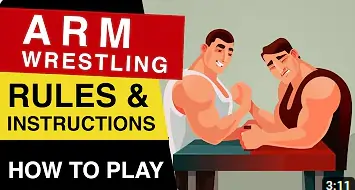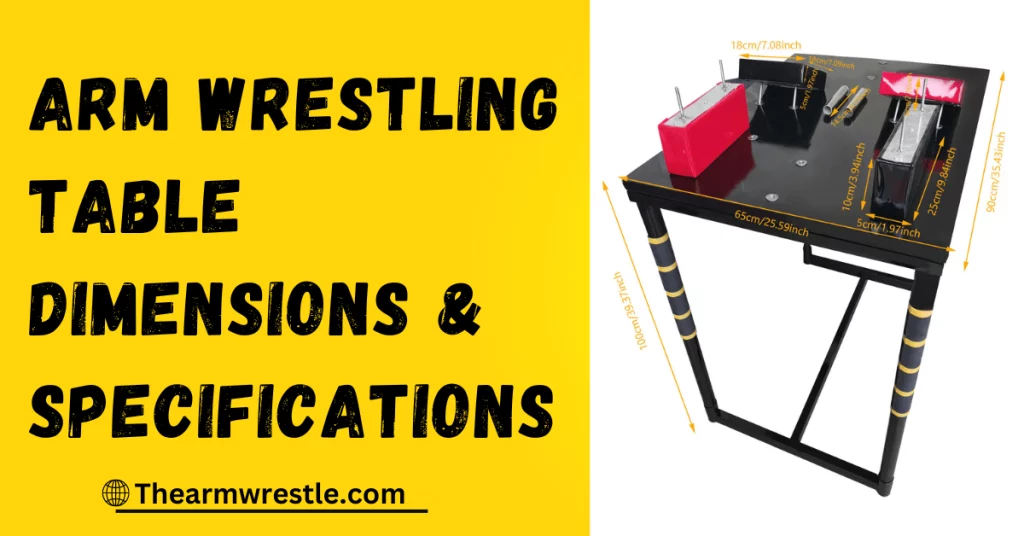Are you looking to improve your arm wrestling game and dominate the table? Whether you’re a beginner seeking to understand the basics or a seasoned competitor aiming to refine your technique, mastering the right workouts and exercises can give you the edge. In this comprehensive guide, you’ll discover proven techniques, essential exercises, and insider tricks that will transform your arm wrestling skills. By the end of this post, you’ll be equipped with the knowledge and strategies needed to overpower your opponents and reach new heights in your arm wrestling journey.
Arm wrestling
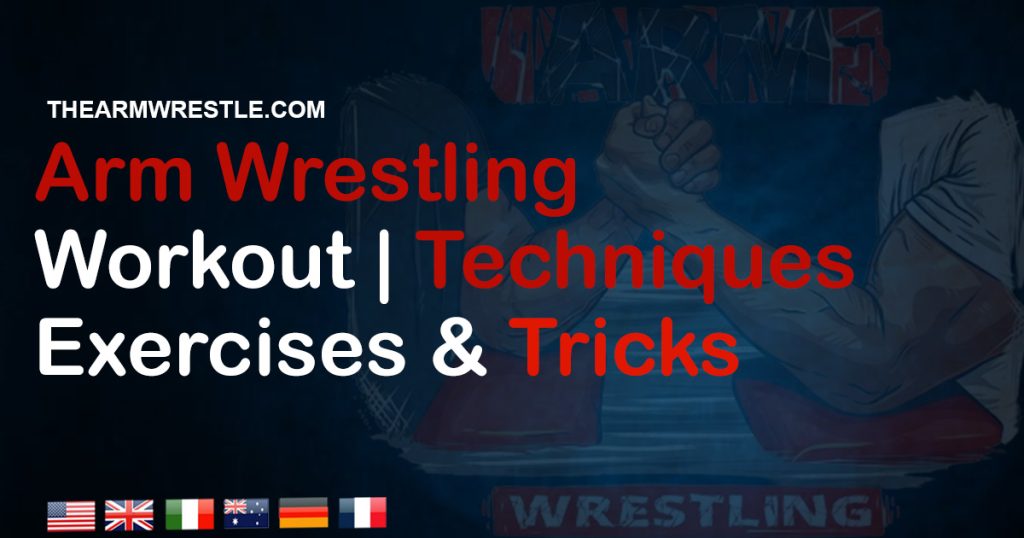
Arm wrestling, also spelled armwrestling, is a sport where two opponents face each other with their elbows on a table and hands tightly gripped. The goal is to pin the opponent’s hand down to the table. Often, people use arm wrestling to see who is stronger. This sport has ancient roots but became popular again in the 1950s in the United States. The first world arm wrestling championship took place in Petaluma, California, in September 1962, originally called “wrist wrestling.” Over time, it has been known by other names such as arm turning, arm twisting, twisting wrists, and wrist turning.
Casual Arm wrestling
Casual arm wrestling is something people often do just for fun or to see who’s stronger. It usually happens when two people sit down anywhere convenient, like at a table or on a chair. Unlike official competitions, casual wrestling doesn’t have strict rules or special tables. Because of this, injuries are more common because people might not be in good shape or know the right techniques. Also, in casual arm wrestling, there’s often a big difference in strength between the participants, which can lead to risky situations and more chances of getting hurt.
Arm wrestling Competition
In competitive arm wrestling, matches happen with both competitors standing at a special arm wrestling table. There are two main types of competitions: tournaments and supermatches. Tournaments involve many participants going through rounds of matches until a winner is found. Supermatches, on the other hand, are between two specific athletes and can have several matches between them. This format is like a traditional bout in other sports. The tables used in these competitions have elbow pads to show where the elbows should stay, pin pads to mark how high a hand must go to be considered pinned, and hand pegs for extra leverage. These tables might differ slightly in size depending on the competition’s rules, but they’re always set up the same way with specific distances between the pads.
Arm wrestling Competition Divisions
In arm wrestling competitions, divisions are organized based on weight classes and dominant hand, similar to other combat sports. Most competitions have separate divisions for left-handed and right-handed competitors. Since right-handed arm wrestlers are more common, competitions for them are both more frequent and more prestigious compared to left-handed ones. Additionally, there are rules in place to maintain fairness, such as penalties for actions like lifting the elbow off the pad, false starts, and attempting to escape being pinned by breaking the grip with the opponent. These rules ensure that matches are conducted fairly and that participants adhere to proper technique during competition.
Here’s a list of common divisions in arm wrestling competitions:
- Weight Classes:
- Lightweight Division
- Middleweight Division
- Heavyweight Division
- Super Heavyweight Division
- Left-handed Division
- Right-handed Division
These divisions help ensure fair competition by grouping participants based on factors like weight and dominant hand. Each division may have its own set of rules and competitions, allowing athletes to compete against others with similar characteristics and abilities.
Arm wrestling History
Arm wrestling has a long history that stretches back centuries. While its exact origins are somewhat unclear, it’s known that arm wrestling was widely practiced in Japan during the Edo period, which began in the 17th century. Artwork from this time depicts people engaging in what looks very much like modern arm wrestling. This Japanese tradition likely contributed to the popularity of arm wrestling around the world.
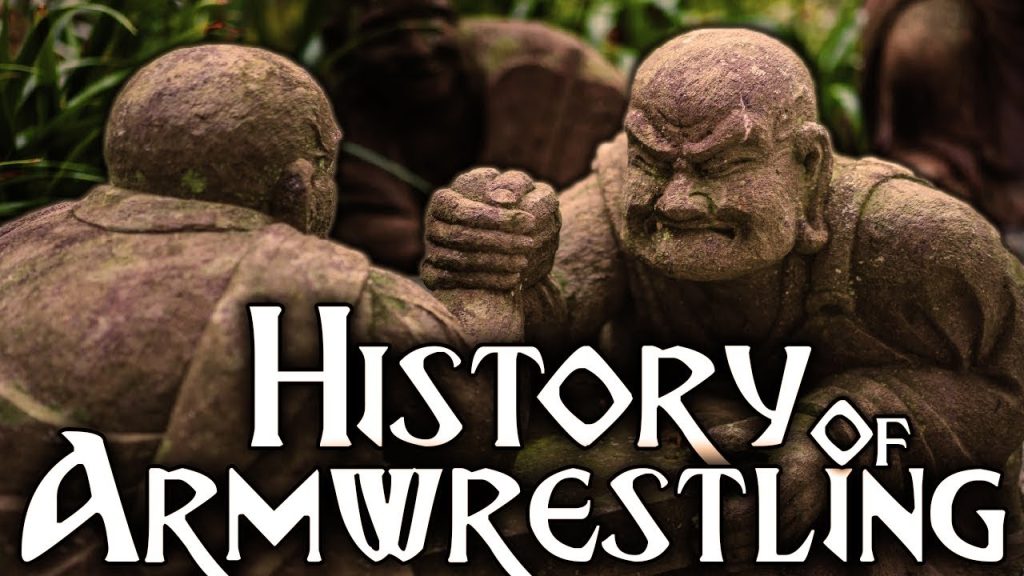
In the 19th century, arm wrestling was also practiced by Spaniards and Cubans, possibly influenced by contact with Japan. In the United States, the sport was sometimes called “Indian arm wrestling,” with some suggesting it originated among Native American peoples like the Lenape. Another similar sport called “Indian hand wrestling” was also popular among American youth, including Boy Scouts, in the early to mid-20th century.
Organized arm wrestling tournaments began to emerge in the 1950s, and the World’s Wristwrestling Championship, Inc. (WWC) organized the first World’s Wrist-wrestling Championship in 1962 in Petaluma, California. These tournaments played a significant role in popularizing arm wrestling as a competitive sport globally.
Types of Arm wrestling
Arm wrestling has different ways to play. You can do the classic one where you sit and lock hands with your opponent. Or if you want more challenge, stand up and arm wrestle. If sitting is more your style, there’s a version for that too. And if you’re into focusing on wrist strength, try wrist wrestling, where you aim to pin your opponent’s wrist instead of their whole arm. It’s all about finding what suits you best and having fun with it!
Here is a straightforward list of the types of arm wrestling:
- Traditional
- Stand-up
- Sit-down
- Wrist
Arm wrestling Workout
To workout in arm wrestling, a targeted workout that strengthens the arm, wrist, and grip is essential. Incorporating specific exercises can significantly improve your performance by enhancing muscle endurance and power. Here’s a list of exercises tailored for arm wrestlers looking to gain a competitive edge:
- Cable Wrist Curls: This exercise focuses on strengthening the wrists, crucial for gaining leverage during a match.
- Hammer Curl: Targets the biceps and forearms, improving grip strength and arm stability.
- One Arm Dumbbell Forearm Curl: Aims at the forearms, enhancing wrist flexibility and grip.
- Pull-ups: Strengthen the upper body and improve grip strength, essential for arm wrestlers.
- Reverse Curl: Works on the forearms and biceps from a different angle, increasing overall arm strength.
- Wrist Roller: A great tool for building wrist and forearm strength, key areas in arm wrestling.
- Dumbbell Rows: Focuses on the back and shoulders, providing the necessary support for a strong arm wrestling foundation.
- Towel Wringing: Simulates the arm wrestling motion, improving grip and forearm endurance.
- Gripzilla Tornado Forearm Roller Curl: An advanced tool designed to enhance grip and forearm strength through dynamic resistance.
Incorporating these exercises into your routine can build the muscle strength and endurance needed for arm wrestling, helping you become a more formidable competitor. Remember, consistency is key, and a balanced approach that includes rest and recovery will yield the best results.
Arm wrestling Techniques
Mastering various techniques and moves is essential to outmaneuver your opponent. Among the multitude of strategies, three primary moves stand out: the hook, toproll, and press. Each move employs a unique balance of pressures from the hand and arm to gain the upper hand in a match.
Hand Pressure
When it comes to applying force, arm wrestling involves a complex interplay of pressures, broadly categorized into hand pressures and arm pressures. Hand pressures are crucial in gaining an advantage. The main technique, known as “cupping” or wrist flexion, involves bending the opponent’s wrist back by flexing your wrist, significantly reducing their leverage. Additional hand pressures include supination (used in a hook move), pronation (used in a toproll), and “rising” (wrist abduction), all aimed at maneuvering the opponent into a less favorable position for an easier pin.
Arm Pressure
Arm pressures, on the other hand, are about leveraging the strength of your arm. Side pressure is achieved through the contraction of the chest muscles and involves a whole-body movement to push against the opponent sideways, aligning with the goal of moving their hand towards the pin pad. Back pressure taps into the power of the back muscles and biceps, pulling the arm towards oneself to compromise the opponent’s arm position and reduce their leverage. Lastly, “posting” or upward pressure, relies on the biceps’ strength to lift the elbow upwards, improving your leverage and positioning against the opponent.
Understanding and applying these pressures effectively can dramatically enhance your performance in arm wrestling, turning each match into a strategic battle of wit, strength, and technique.
Moves and Styles
In arm wrestling, there are three main techniques competitors use to outmatch their opponents: the hook, the toproll, and the press. Each technique has its unique approach and strategy, making arm wrestling a blend of strength, skill, and tactics.
Hook
Imagine arm wrestling by really getting your arm into a tight grip with your opponent’s. That’s the hook. It involves turning your wrist inward, which puts a lot of the battle into how strong your wrist can push. It’s a move that relies heavily on your arm’s muscle power, especially your biceps. Unlike other moves, winning with a hook is more about how strong your arm is rather than how skillfully you can maneuver your hand.
Toproll
The toproll is the trickster of arm wrestling moves. It’s all about turning your hand outward, making your thumb the main point to apply pressure. This move requires a good deal of strategy and a strong grip, as it’s about outsmarting and overpowering your opponent’s hand through clever movements. It’s different from the hook because it focuses more on technique and forearm strength.
Press
Also known as the shoulder press, this move is like using your body’s weight to your advantage. Wrestlers twist their bodies to line their shoulder right behind their hand, giving them the chance to push down using their triceps and body weight. It’s a strategic move often used to finish off an opponent, especially when the match is leaning in your favor. Whether you start with a hook or a toproll, switching to a press can give you the upper hand to win.
Each technique in arm wrestling offers a different path to victory, showcasing the sport’s rich mix of physical power and strategic depth. Whether through the brute force of the hook, the clever angles of the toproll, or the pressing power of the shoulder press, there’s a method for every competitor’s style.
The Mechanics of Arm Wrestling
Arm wrestling, more than just a contest of brute force, is an intricate sport where understanding the mechanics is key to triumph. Central to its practice are three elements: leverage, strength, and technique, each playing a critical role in determining the outcome of a match.
Leverage, the cornerstone of arm wrestling, involves using one’s arm as a lever to exert maximum force on the opponent. It’s not merely about who has bigger muscles; it’s about how effectively one can apply those muscles. Positioning the arm at an optimal angle can significantly enhance the force exerted, making leverage a decisive factor.
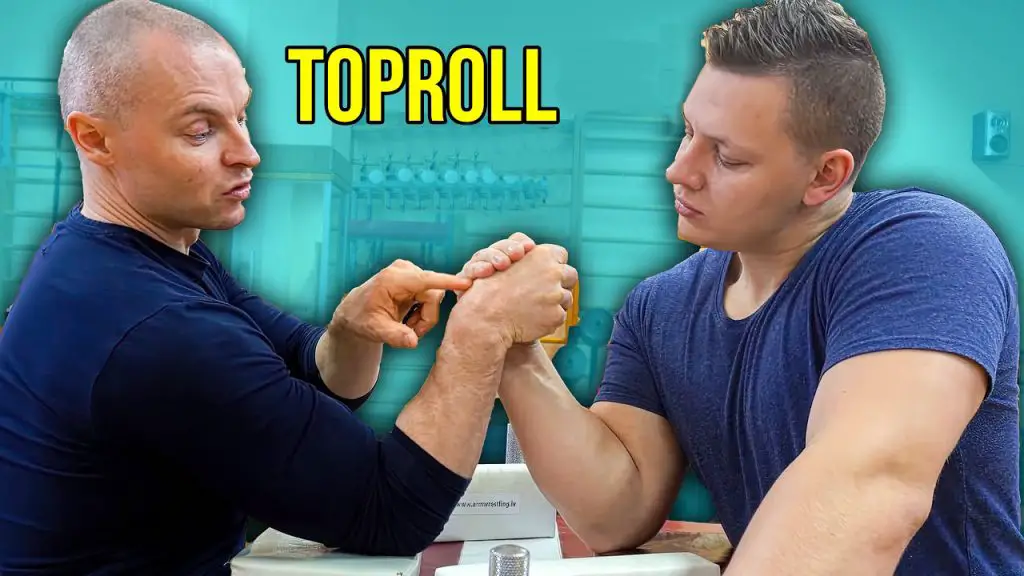
Strength, while an obvious component, is nuanced in arm wrestling. It’s not just overall muscular strength that counts, but the strength of specific muscle groups, particularly the forearm, biceps, and shoulder muscles. Effective arm wrestlers train these areas rigorously to develop the power necessary for the sport.
Technique, however, is what truly separates seasoned arm wrestlers from novices. It encompasses a range of strategies, from the grip—either a top roll or a hook—to the initial burst of force and the subsequent adjustments during a match. Mastering various techniques allows a competitor to adapt to different opponents and situations, making it a crucial aspect of the sport.
Arm Wrestling Training
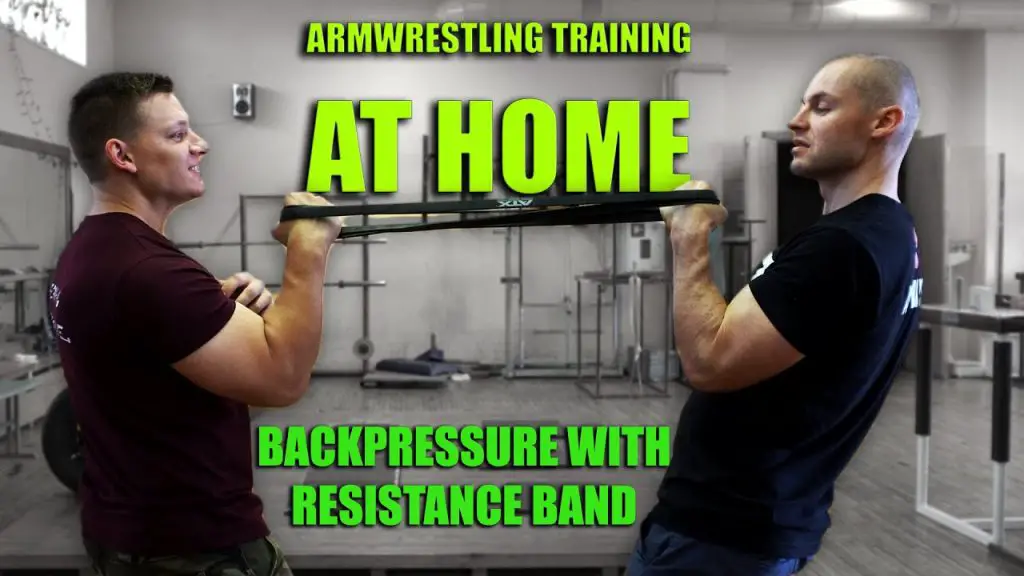
Training for armwrestling is multifaceted, involving:
- Strength Training: Focused exercises for arm and upper body strength.
- Endurance Training: To sustain force over prolonged periods.
- Technique Practice: Repeated drills to master various grips and moves.
Arm wrestling Rules
Arm wrestling is a sport with simple arm wrestling rules that make it exciting and fair for everyone involved. The basic idea is to pin your opponent’s arm down to the table. Before the match starts, both competitors grip each other’s hand over a table, with their elbows planted firmly on the surface. The match begins when the referee says so, and from there, the goal is to use your strength and technique to move your opponent’s arm to the touchpad on your side of the table. You must keep your elbow on the pad at all times during the match; lifting it off can lead to a foul. Winning requires a combination of power, strategy, and skill to outmaneuver your opponent. There are also rules against twisting your wrist too much (to avoid injuries) and moving your body in certain ways that give you an unfair advantage. The match is overseen by a referee, who makes sure all rules are followed and declares the winner once a competitor’s arm has been successfully pinned.
Arm Wrestling Equipments
In arm wrestling, the equipment used is straightforward but essential for ensuring fair competition and safety. The centerpiece is the arm wrestling table, which is specifically designed for the sport. This table has a flat surface with pads for the competitors’ elbows, ensuring comfort and stability. There are also grip pads or handles for the competitors to hold onto, providing leverage and preventing slippage. In professional settings, the table may also feature touch pads on either side, indicating where an arm must be brought to secure a win.
Additionally, competitors might use wrist straps or chalk to improve their grip. Wrist straps are sometimes used in matches to keep the competitors’ hands together when their grip fails, while chalk helps reduce moisture, improving hand grip. These basic pieces of equipment help maintain the sport’s integrity, focusing the competition on skill, strength, and technique rather than external factors.
Psychology
In arm wrestling, psychological factors are as pivotal as physical strength. Confidence is key; a self-assured arm wrestler can instill doubt in their opponent, gaining a mental edge even before the match begins. Intimidation tactics, whether through body language or demeanor, can also play a crucial role in swaying the outcome. The mental game extends to understanding and predicting an opponent’s strategy. Reading subtle cues and anticipating moves allows a competitor to counteract effectively, turning the tide in their favor. This blend of mental resilience, strategic foresight, and psychological warfare adds a rich layer of complexity to arm wrestling, making it a sport where mind and muscle work in unison.
The Competitive Scene
Arm wrestling boasts a dynamic and diverse competitive arena that spans from grassroots local contests to high-profile international championships. This spectrum of competition allows for a wide range of participants, from amateurs testing their strength for the first time to seasoned professionals vying for global recognition. At the local and amateur level, arm wrestling serves as a community-building activity, often featured in festivals, fairs, and social gatherings. These events are crucial for nurturing new talent and fostering a passion for the sport.
On the global stage, prestigious events like the World Armwrestling Championships and the European Armwrestling Championships represent the pinnacle of competition. These international tournaments draw the best arm wrestlers from across the globe, showcasing a remarkable level of skill and athleticism. They are not just competitions but celebrations of the sport, highlighting its universal appeal and the camaraderie among its practitioners.
Conclusion
In summary, arm wrestling is a sport that uniquely blends strength, strategy, and skill. It’s a direct contest of power and tactics, where simple equipment like the specialized table and grip-enhancing chalk ensures fairness and focuses on the athletes’ abilities. Arm wrestling’s charm lies in its simplicity and the intense personal competition it fosters. It appeals to a wide range of enthusiasts, from beginners to seasoned competitors, offering a community that values physical prowess as much as mental toughness. This sport embodies the essence of competition, providing a captivating and straightforward challenge that is both inclusive and demanding.

